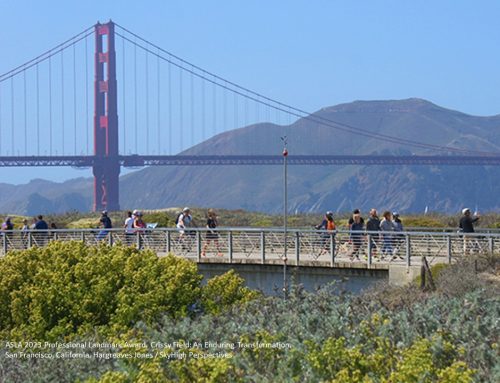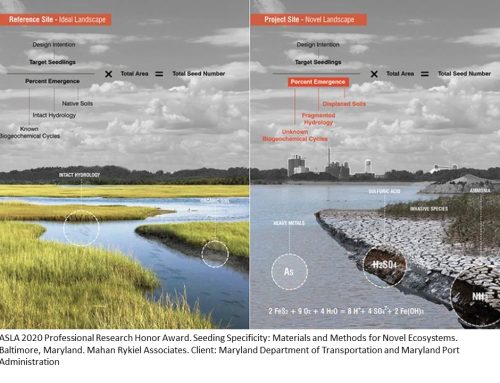by Jan Merryweather, PlantRight
I saw Elvis today.
Actually, he's quite the regular at Sustainable Conservation's San Francisco headquarters these days. More than a titan among musical icons "The King" has become a muse to the PlantRight team, especially this National Invasive Species Awareness Week . We love Elvis' "A Little Less Conversation" because it might as well be our theme song for actionable awareness. We can't guarantee you'll be dancing along by the end of this article, but we do guarantee providing you with a few awareness-raising resources, a deeper understanding of what's holding back the hold-outs from taking positive action, and most importantly what we can do about it.
PlantRight defines "actionable awareness" as what happens when individuals and businesses are made aware of an opportunity to be part of the solution to California's costly (economically and environmentally) invasive garden plant problem, and make a conscious decision to act. Invasive plants (despite the fact that many are deceptively beautiful and drought resistant) outcompete native plants, alter soil chemistry, increase wildfire risk, clog our waterways and can severely compromise agricultural yields and real estate value. If that weren't enough, invasive species are the second greatest threat to biodiversity after human development.
Awareness of these facts alone will not fix any of these issues; however, add action to the mix and you have a proven formula for problem solving. PlantRight's idea of problem solving is collaborating with the industry to voluntarily phase invasive plants out of the supply chain and replace them with high-quality (i.e. non-invasive) plants. Voila! Together we prevent new invasive garden plants from wreaking havoc on our wild lands and taxpayer wallets.
A Little Less Conversation, a Little More Action Please
The fact that 50% of California's invasive plants are of horticultural origin (Bell et al. 2007) is a source of both conversation and dismay. Yet from PlantRight's perspective this 50% is a great source of optimism because it's proof of a huge opportunity the nursery industry can play in preventing future invasive plant introductions. In past decades ornamental plant breeders and growers had little or no ability to predict a plant's invasive risk in a given region, and most invasions were well-intentioned accidents. Lucky for us we finally have science-based plant risk evaluation tools to prevent new invasive plant introductions. Not so lucky for us is that popular plants travel, and a delightful Dr. Jekyll plant in one region, may become a hideous Mr. Hyde plant and landscape transformer in a different region. It's about the right plant in the right place, as our friends at AmericanHort like to say. But just where to begin, if we're to turn this talk into actionable awareness?
In the beginning there was lots of conversation and lots of listening sessions that Sustainable Conservation conducted with a diverse group of nursery industry stakeholders, from large ornamental growers, retail nurseries, plant scientists, trade associations and government agencies. This group's official moniker is "California Horticultural Invasive Prevention," but we prefer Cal-HIP.
With a couple years of listening and learning under our belts, and funding from Sustainable Conservation, the PlantRight program was ready for action: action engaging the nursery industry in voluntarily phasing our invasive ornamental plants and promoting, in their place, non-invasive alternatives.
Our first order of business was to measure the scope of the problem and establish a baseline. Working closely with plant science experts to identify the most problematic invasive ornamental plants, and industry experts to identify non-invasive alternatives, we created our first PlantRight plant list. If you can measure it you can manage it, we like to say – to do this, we rely on an annual Spring Nursery Survey. Each spring, we work with over 100 volunteers to survey more than 200 nurseries and garden centers around the state, and in the process track the retail market for invasive garden plants in California.
Along with informing our program strategy, the annual survey allows us to keep PlantRight's plant list manageable and up to date , we add new invaders and retire those that are largely phased out of the trade. It is our program's calling card, and the starting point for conversations with prospective partners and skeptics, alike. It has earned the enthusiastic support of California Certified Nursery Professionals (CCNPro), SaveOurWater, and more.
However, unlike an Elvis concert venue where if you build it they will come, building a plant list, alone, is just the starting point for rallying stakeholders. Going from starting line to finish line takes understanding barriers to planting right and how to engage the invasive plant skeptics and businesses feeling aggravated (and sometimes attacked) by conservation efforts to stop the sale of invasive plants.
All this Aggravation Ain't Satisfactioning Me
Over the past several years we've come to understand the prime source of aggravation that prevents good people and well-meaning business owners from planting and promoting exclusively non-invasive plants. Here's our top five list and what we can recommend for empowering folks to act.
- Confusion! What do we mean when we talk about "invasive plants" ?
"Invasive" is a term that is ill-defined, frequently misused and in general very confusing. Anytime we meet with retailers, growers, landscape professionals or other new stakeholders we define the term according to the Federal Invasive Species Advisory Committee's definition of "invasive plant," which is:
Plants that are not native to the ecosystem under consideration and that cause or are likely to cause harm to the economy, environment, or to human health… In the technical sense, the term ''invasive'' simply denotes the uncontrolled or unintended spread of an organism outside its native range. Differing perceptions of the relative harm caused or benefit gained by a particular organism are influenced by different values and management goals. If invasive species did not cause harm, we would not be nearly as concerned… Finally, a non-native species might be considered invasive in one region but not in another. (Beck et al. Invasive Species Definition, April 2006)
Speaking of definitions it is also important to understand that words such as "alien," "exotic," "non-native," "weed," and "naturalized" are regularly and incorrectly used to describe invasive plants. Just last fall both Harper's and The Economist magazines featured stories reinforcing such misuse of terminology. Research is clear: the vast majority of non-native plants and naturalized plants pose little or no invasive risk, and countless non-native plants contribute mightily to our quality of life, economy and food systems. Words do matter, so thanks for saying what you mean and using these terms correctly to shed some much needed light on all this invasive confusion.
Once everyone's on the same page, it gets easier to engage all nursery stakeholders and get closer to the source of their issue. In our experience the remaining hold-outs , retailers, landscape professionals or growers , justify their stance with one or all of the following:
- "There's no economic incentive for me. I don't want to miss out on a sale, or disappoint a loyal customer."
That is one way to look at the situation; but let's not forget the glass-half-full perspective. Growers and retailers who promote exclusively non-invasive plants have every economic incentive to do so, if only they communicate the value-add to customers.
In February’s Greenhouse Grower magazine (page 80), Managing Editor Janeen Wright’s column (page 80) opens with: "Going green – it’s becoming as common in the green industry as petunias, and even more relevant to profitable growth. So much of the conversation lately circles around to breeding and growing plants that uphold the sustainable, ecologically responsible lifestyles consumers are choosing to live."
The demand for labeled ornamental plants has been the subject of numerous studies which have indicated that consumers are willing to pay a price premium on products bearing such labels. Labeling allows producers to readily present information pertaining to unobservable environmental attributes associated with producing or consuming a particular good. The Millennial generation (today's 15 to 35-year olds) which accounts for about one-third of the global population, are technologically savvy and socially engaged. Millennials are less brand loyal than older consumers and want to know the story behind products and brands. A label or shelf talker can tell this environmentally-friendly story.
Increased utility and a willingness to pay this premium for a label have been found for: powdery mildew-resistant flowering dogwoods; Texas Earth-Kind™ and Superstar™ plants; "origin-certified" native plants; plants grown in biodegradable containers and those that are carbon-saving; non-invasive and native plants; privately certified eco-labeled roses and low-carbon footprint roses; and plants grown using energy-saving production practices, sold in non-plastic containers, and locally grown plants. (D'Alessio Nicole, Adding Value to Ornamental Plants, American Nurseryman Magazine, January 12, 2015)
- "What difference will my action make? It's a drop in the bucket!"
The best antidote for those moments of feeling powerless, especially in this El Niño year, is advice from Frances Moore Lappé: "Wait a minute. If you have a bucket, those raindrops fill it up very fast. Being a drop in the bucket is magnificent. The problem is we often lose sight of the bucket. Our work is helping people see that there is a bucket."
- "Others are doing (selling) it , why not me?"
We heard this from a director of horticulture at a garden center chain, not too long ago. He had recounted seeing more than a couple new developments breaking ground and landscapes featuring invasive plants. This really comes down to values , personal values, and business/brand values. Since actions speak louder than words (or slick ad campaigns), this is all about what you or your business want to be known for. Making a commitment to buy and sell only non-invasive plants is great way to demonstrate that you value the environment.
- "I live in the center of a concrete urban area, what's the harm of my buying and planting invasive plants in my garden?
This is a great question! The harm is this: when people purchase invasive plants it sends a positive signal back up the supply chain to produce more. And, despite their relatively stationary existence, wind, water, and other seed-vehicles like birds can carry seeds and plant fragments miles, allowing them to spread even from unlikely locations like city centers. So, even if your home is far from open space make sure to ask your local garden center about non-invasive alternatives, or visit the PlantRight list to get some tips. There are plenty of beautiful non-invasive plants that can meet your home and garden needs.
Hopefully these provide you with more insight, understanding and resources to have even more meaningful conversations with those friends and businesses you know who have been struggling – in a state of inaction, about buying, selling and planting exclusively non-invasive plants.
A Little Less Fight, a Little More Spark
Buying non-invasive means many things, including protecting native species, being good stewards of our beautiful open spaces and waterways, being fiscally responsible and preventing additional taxpayer dollars going to avoidable invasive plant eradication efforts. Buying non-invasive plants is casting a vote for the kind of world you want to live in.
So, why on earth do people buy invasive plants in the first place?
(Hint: One big reason has to do with what happens when you turn off the lights)
Yep, people who purchased invasive plants were in the dark , they did not know.
Working with a group of pro-bono consultants (thank you, Inspire and Bain & Co, San Francisco!) in 2013, we learned that the primary drivers behind consumer purchases of invasive plants are: 1) aesthetics , it looks good; and, 2) there was no information on the plant indicating "invasive." In other words the majority of invasive plant purchases (by consumers) are impulse purchases and would not have occurred had the plant been properly identified as "invasive."
Nan Sterman, award winning garden writer and host of PBS' "A Growing Passion," has her own answer to this vexing invasive plant question. "It's about visual influence," says Sterman. "People tend to buy and plant what they see in their local gardens and landscapes. " According to Sterman, these include the very people who religiously recycle, buy high-efficiency appliances, and drive electric cars, yet they can't imagine beautiful, drought tolerant plants posing environmental problems. Nassella tenuissima, or Mexican feathergrass, is one such culprit that has been romancing many well-intentioned Californians.
All of which sparks bright opportunities for retailers and landscape professionals to add value for customers and clients interested in buying environmentally-friendly plants. Don't leave your retail customers in the dark. You're the expert, so share your expertise! Letting customers know that your business promotes exclusively non-invasive plants will spark greater customer loyalty and profits.
You will also be in the very fine company of leaders and organizations who are leading by example, including PlantRight Retail Nursery Partners, Monrovia, Altman Plants, APLD-CA, UC Master Gardeners, California Association of Nurseries and Garden Centers, Association of Professional Landscape Designers-CA Chapter, American Society of Landscape Architects , NorCal, California Native Plant Society, California Landscape Contractors Association, SaveOurWater, UC Integrated Pest Management, California Urban Water Conservation Council, and EcoLandscape.
Come On, Come On…
Ready to channel your inner Elvis and tackle invasive garden plant problems in ways that make economic sense? (Of course you are!) Here are a few resources to empower more action in your community.
- Share this article
- View our Plant List at PlantRight.org
- View our 2016 Invasive Plants Webinar
- Invasive Plants and Horticuluture in California study guide
- 2015 Spring Nursery Survey Fact Sheet
- How to Speak with Retail Nurseries
- Invasive Plant IQ Test
- Little Less Conversation, Little More Action video
So this National Invasive Species Awareness Week we encourage you to crank up that volume and bust a move with the PlantRight community (blue suede shoes optional), knowing that YOU are driving actionable awareness… this week, this month and in the years ahead.
And for those retail garden centers, nurseries and landscape professionals who talk about providing "quality plants," "adding value to customers," being "environmentally responsible," or their "commitment to excellence in the nursery industry," we invite you to join us in promoting exclusively non-invasive plants for California. Until you do, talk is cheap , it's action that matters.
Thank you, thankyouverymuch!




